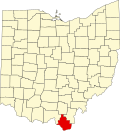2000 census
As of the census [14] of 2000, there were 62,319 people, 24,732 households, and 17,807 families living in the county. The population density was 137 inhabitants per square mile (53/km2). There were 27,189 housing units at an average density of 60 units per square mile (23/km2). The racial makeup of the county was 96.55% White, 2.09% Black or African American, 0.18% Native American, 0.19% Asian, 0.01% Pacific Islander, 0.11% from other races, and 0.88% from two or more races. 0.57% of the population were Hispanic or Latino of any race.
There were 24,732 households, out of which 32.00% had children under the age of 18 living with them, 56.00% were married couples living together, 11.90% had a female householder with no husband present, and 28.00% were non-families. 24.90% of all households were made up of individuals, and 11.20% had someone living alone who was 65 years of age or older. The average household size was 2.49 and the average family size was 2.96.
In the county, the population was spread out, with 24.50% under the age of 18, 8.60% from 18 to 24, 28.00% from 25 to 44, 24.50% from 45 to 64, and 14.40% who were 65 years of age or older. The median age was 38 years. For every 100 females there were 92.20 males. For every 100 females age 18 and over, there were 88.40 males.
The median income for a household in the county was $29,127, and the median income for a family was $35,308. Males had a median income of $30,622 versus $20,961 for females. The per capita income for the county was $14,678. About 15.10% of families and 18.90% of the population were below the poverty line, including 27.30% of those under age 18 and 12.90% of those age 65 or over.
2010 census
As of the 2010 United States Census, there were 62,450 people, 24,974 households, and 17,405 families living in the county. [15] The population density was 137.7 inhabitants per square mile (53.2/km2). There were 27,603 housing units at an average density of 60.9 per square mile (23.5/km2). [16] The racial makeup of the county was 95.9% white, 2.0% black or African American, 0.4% Asian, 0.2% American Indian, 0.2% from other races, and 1.4% from two or more races. Those of Hispanic or Latino origin made up 0.7% of the population. [15] In terms of ancestry, 18.0% were American, 15.4% were German, 12.9% were Irish, and 10.8% were English. [17] In Lawrence County, less than 1% of people who self-identify as "Irish" are Catholic. Scholars believe this is part of a trend in which people are vaguely aware that at least some of their ancestors come from Ireland, but that population is primarily of "Scots-Irish" or "Ulster Scots" ancestry, and those identifying as "Irish" are simply unaware of the distinction. [18] Those citing "American" ancestry in Lawrence County are of overwhelmingly English extraction, most English Americans identify simply as American because their ancestors have been in North America for centuries—in some cases since the 1600s. [19] [20] [21] [22] [23]
Of the 24,974 households, 32.9% had children under the age of 18 living with them, 51.0% were married couples living together, 13.2% had a female householder with no husband present, 30.3% were non-families, and 26.1% of all households were made up of individuals. The average household size was 2.47 and the average family size was 2.95. The median age was 40.1 years. [15]
The median income for a household in the county was $36,461 and the median income for a family was $46,732. Males had a median income of $38,170 versus $28,251 for females. The per capita income for the county was $19,452. About 15.2% of families and 19.4% of the population were below the poverty line, including 28.0% of those under age 18 and 11.9% of those age 65 or over. [24]







